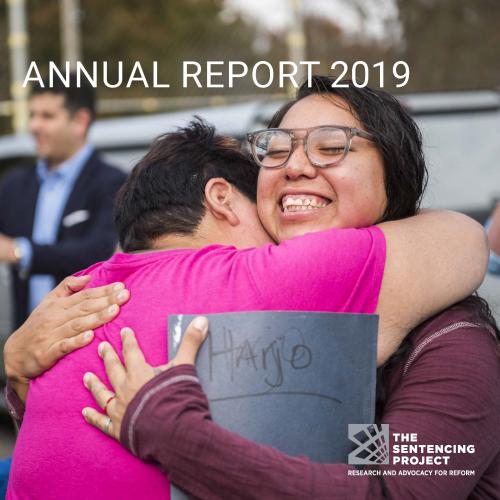04 April 2020 :
The Sentencing Project, within its "ANNUAL REPORT 2019" (published March 18, 2020), has published the report "The Facts of Life Sentences" which contains (relatively) updated data on life sentences in the United States. At the end of 2016, 206,000 people were serving a life sentence in prisons in the United States. These are the same numerical data, and the same time frame, already taken into consideration in a previous report: "Still Life: America's Increasing Use of Life and Long-Term Sentences", published, also by the Sentencing Project, on May 3, 2017 and Hans off Cain summed up in a news of 01/29/2018 (see). If the absolute numbers are the same, the type of analysis that is now offered is different. Senior Research Analyst Ashley Nellis developed a series of fact sheets on life sentences in the United States in 2019. The first in the series, The Facts of Life, provides an overview of policies that have contributed to the expansion in life sentences, including extending parole wait times, mandatory minimum sentences, transfer of juveniles to the adult system, and the abolition of parole in some states. The number of people serving life sentences, 206,000, is at an all-time high. Virtual life. Virtual life sentences are those that typically amount to life imprisonment, 50 years or more, but are not statutorily defined as such. In Virtual Life Sentences, Ashley highlights the first-ever count of this population, revealing that 44,311 people are serving such sentences. In nine states — Arkansas, Florida, Illinois, Indiana, Louisiana, Maryland, Pennsylvania, Tennessee, and Texas, as well as the federal system — at least 1,000 people are serving these sentences. As with life sentences generally, racial disparity is evident among virtual lifers. More than half of those serving virtual life sentences are African American. Women and girls. Nationwide, one of every 15 incarcerated women is serving a life sentence, according to Women and Girls Serving Life Sentences. While men comprise the overwhelming proportion of people in prison for life, the number of women serving life sentences is rising more quickly than it is for men. Compared to men, women serving life sentences report higher levels of psychiatric disorders, histories of physical and sexual violence, and previous suicide attempts. Youth. Sentencing youth to potentially lifelong imprisonment is virtually nonexistent anywhere else in the world. In the United States, nearly 12,000 people are serving a life sentence for a crime they committed under the age of 18, reports Ashley in Youth Sentenced to Life Imprisonment. Despite evidence that adolescent brain development should mitigate the culpability of youth, all states allow juveniles to be sentenced to life imprisonment, and all but two states have persons serving a life or “virtual life” sentence for a crime committed as a juvenile. The facts of life sentences 1 in 7 people in prison is serving a life sentence. The unprecedented growth of life sentences in the United States runs counter to declining crime rates and growing challenges to mass incarceration. The overwhelming majority of individuals who commit crime—even serious crime—will “age out” of criminal behavior, and their continued incarceration diminishes returns on public safety. This is both wasteful and inhumane. To provide a better approach to advancing public safety, sentencing policies in the United States should be capped at a maximum of 20 years in prison, except in circumstances in which the individual still represents a clear threat to public safety. The spread and scale of life imprisonment. At the onset of mass incarceration, the United States incarcerated 200,000 individuals in state and federal prisons. Today, there are more people serving life sentences than the entire prison population of the early 1970s. Indeed, the number of people serving life sentences – including life without the possibility of parole (53,290), life with the possibility of parole (108,667), and “virtual” life sentences of 50 years or more (44,311) – is at an all-time high. Characteristics of people serving life sentences. Though most life sentences are reserved for those who have committed serious and often violent crimes, over 17,000 individuals serving life have been convicted of a nonviolent offense, including 5,000 convicted of a drug offense. 59% of lifers are serving sentences for homicide, 17% for rape or sexual assault, and 15% for aggravated assault, robbery, or kidnapping. While people of color are over-represented in prisons and jails; this disparity is even more evident among those sentenced to life imprisonment, where one of every five African American prisoners is serving a life sentence. Over 6,000 women are serving life or virtual life sentences. The number of women serving life sentences has risen at a faster rate than for men in recent years. Between 2008 and 2016, women lifers increased by 20%, compared to a 15% increase for men. Juveniles serve life sentences at alarming rates as well. In fact, the U.S. is unique in the world in its use of life imprisonment without parole for crimes committed by teenagers. In addition to the more than 2,000 people serving life without the possibility of parole, there are more than 7,000 juveniles serving life with parole and another 2,000 serving “virtual life” prison terms of 50 years or more. Rapid expansion of life sentences. The number of lifers has grown faster than the prison population. The life-sentenced population has continued to rise even as prison populations have recently seen modest declines and while crime rates are at historic lows. Though violent crime rates increased during the 1980s, they have fallen by 49% since 1991. Many other countries that experienced a similar crime drop did not rely on harsher punishments during this period. In fact, although the United States represents just 4% of the world’s population, it holds 40% of the world’s life-sentenced population. Factors contributing to lifer population growth. The National Academies of Science has reported that changes in policy, not crime rates, account for the dramatic rise in imprisonment since 1980. So too is this the case for life sentences. Two key factors that have driven the historic rise in life sentences: 1) More people sentenced to life imprisonment. A driving force in the expansion of life sentences has been the proliferation of mandatory sentencing and habitual offender laws. Rather than targeting individuals who pose the greatest risk to public safety, in many cases these laws have widened the net to impose life sentences on individuals who do not require decades-long incapacitation for public safety purposes. 2) Delays in paroles and restricting commutations for qualified prisoners. Many jurisdictions have made parole more elusive by delaying parole hearings, politicizing parole board actions to reduce parole grant rates, and limiting procedural rights at parole hearings. Executive clemency by a governor or president as a tool to recalibrate sentence lengths was historically relied on regularly. As this release mechanism has become entangled with politics it has largely been abandoned.









